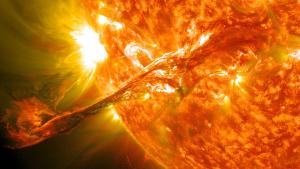Blog
You Could Have Died!
25 July 2014
 NASA/SDO/GSFC
NASA/SDO/GSFCGrowing up I was a bit of a risk taker. Along with a few of my friends, I occasionally did things that (while very cool) were in retrospect notoriously dangerous. Occasionally my Mom found out about these activities, which worried her to no end. As she put it, “You could have died!” This is absolutely true. Some of the stunts we pulled could have ended in serious injury or death. It is also true that my friends and I survived childhood largely unscathed. The reason I bring this up is because recently there has been a flurry of stories about solar activity in 2012, and the headlines are much the same “You could have died!”
There is some truth to this. In 2012 there was a very large coronal mass ejection emitted by the Sun. A coronal mass ejection (CME) occurs when a burst of solar material (mostly ionized hydrogen) is blasted off the Sun. These happen fairly regularly when the Sun is in an active period. If it occurs in the direction of Earth, the ionized material interacts with the Earth’s magnetic field, and are driven toward the polar regions where they and produce northern (and southern) lights.
This type of solar activity can have large effects on us, such as causing power outages. In 1989 a large solar flare triggered a regional blackout in Quebec. There was also a very large CME that led to the “Carrington Event” of 1859, which was so intense it produced northern lights as far south as the Caribbean. It also induced currents in telegraph lines. The storm induced enough current in the lines that messages could be sent across them even while the lines were disconnected from their power supplies. If such an event occurred today, it would likely cause massive blackouts worldwide. It could cause trillions of dollars in damage, and would take several years to fully recover. Such a large disruption of infrastructure would almost certainly lead to some deaths.
If the 2012 CME had occurred a week earlier, then it would have produced a Carrington-scale event. People would have died, and among those could have been you or me. It is also true that in 2004 the 4 km wide asteroid 4179 Toutatis came within 4 lunar distances of colliding with Earth. If it had a slightly different orbit, we could have died.
But we didn’t.
Therein lies the challenge of reporting events like this. On the one hand, our modern technological infrastructure does face a very real risk from solar activity. Studies of ice cores indicate that solar storms such as the Carrington Event only occur about once every 500 years, so it isn’t very common, but the risk isn’t zero either. It is also very clear that our infrastructure is not prepared for a Carrington event, and should be. On the other hand, we don’t want to overplay the risk either. Having this CME miss us by a week is about the same as having a 4 km rock miss us by a few lunar distances. In the past, without detailed astronomical studies, we wouldn’t have known about them at all.
If we can use this information to be better prepared in the future, then that is to our advantage. But if we simply use stories to scare people with doomsday scenarios, then we’re better off not knowing about them.